(Tiranë, 12. 10. 2012) – Zbulimi i fjalëve pellazge/shqipe “VIJ” dhe “DOR (ose bor)” në kulturën Vinça-Tartaria-Dispilio-Maliq-Cakran, mijëvjeçari i 6 p.e.s., tregon se kjo është gjuha më e lashtë e shkruar në botë me abecedarin e saj më të vjetrin në botë. Gjuha pellazge, shkrimi dhe alfabeti i saj, përbëjnë thelbin kulturor të Qytetërimi Pellazg, qytetërimi më i lashtë perëndimor, pjesë e të cilit janë Qytetërimi Minaik i Kretës, Qytetërimi i Trojës, Qytetërimi i Mikenës, Qytetërimi hitit, Qytetërimi etrusk etj. Qytetërimi Pellazg shfaqet qysh gjatë gurmesmit, rreth 12.000 vjet p.e.s.
Në historinë e alfabetit si më i vjetër përmendet ai egjiptian, krijuar rreth vitit 2900 p.e.s. Nga ky më pas rrjedh alfabeti fenikas, i shekullit të 11 p.e.s., i cili kishte vetëm bashkëtingëlloret dhe ku zanoret nënkuptoheshin. Më pas nga fenikasit, shkruhet se alfabetin e morën grekët, e përmirësuan edhe me zanoret dhe prej tij rrodhi më pas alfabeti latin. Asnjë fjalë nuk thuhet mbi alfabetin pellazg, që përmendet shpesh nga autorët antikë. Nga kërkimet tona të fundit mbi alfabetet, puna qëndron krejt ndryshe: njerëzit e parët që kanë shpikur dhe përdorur shkrimin dhe alfabetin për të shkruar gjuhën e tyre kanë qenë pellazgët dhe kjo gjatë mijëvjeçarit të 6 p.e.s., për të cilën ka prova mjaft bindëse. Alfabet pellazg i kishte të dyja, zanoret dhe bashkëtingëlloret.
Në kulturën neolitike të Vinçës, që shtrihet në të gjithë Ballkanin gjatë mijëvjeçarit 6-5 p.e.s., janë ndeshur mbishkrime të lashta gjer tashti të pavlerësuara nga ana gjuhësore. Në figurat 1 dhe 2 tregohen një enë balte nga kjo kulturë me mbishkrimin e lashtë pellazg dhe një copë ene, që mban germën “M” të alfabetit. Shprehja: IIIVIJV1, e cila po të ndahet, bëhet: III VIJ V 1.

Fig. 1 – Enë balte me mbishkrim në kulturën Vinça (5500-4500 p.e.s.)
…………………………………………….
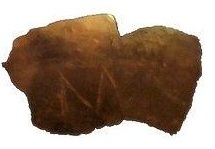
Fig. 2 – Fragment tjegulle, me germën “M”
…………………………………….
Fjala “VIJ” lexohet “UIJ”, sepse në mbishkrimet e lashta pellazge/etruske germa “V” lexohet si “U”. Prandaj kemi fjalën “UIJ” = “UJ” (UJË), në gjuhën pellazge/shqipe. Mbishkrimet e lashta pellazge dhe etruske kanë afërsi shumë të madhe me gjuhën e sotme shqipe, gjë që tregon për një gjuhë pellazge/shqipe. Prandaj mbishkrimi i mësipërm i përket gjuhës së lashtë pellazge. Edhe numrat “1” dhe “III” etj. i përkasin gjithashtu gjuhës pellazge. Edhe simbolet e tjera të gjetura në kulturën e Vinçës janë mjaft interesante dhe paraqesin lidhje të ngushta me pellazgët autoktonë, sidomos shenjat, ![]() janë shenja-germa të alfabetit të përdorur në shkrimin e Linearit A dhe B, të cila njësohen me I, Y, Y, T, F, I, P, Z (S), N, F, Z (S), Th. Edhe shenjat e tilla si I, II, III, IIII, IIIII, IIIIII, X, XX, etj. shprehin ato shenja, që më vonë u përpunuan nga etruskët si I, II, III, IV, V, VI dhe romakët, duke marrë emrin “numrat romakë”.
janë shenja-germa të alfabetit të përdorur në shkrimin e Linearit A dhe B, të cila njësohen me I, Y, Y, T, F, I, P, Z (S), N, F, Z (S), Th. Edhe shenjat e tilla si I, II, III, IIII, IIIII, IIIIII, X, XX, etj. shprehin ato shenja, që më vonë u përpunuan nga etruskët si I, II, III, IV, V, VI dhe romakët, duke marrë emrin “numrat romakë”.
Edhe shenja të tilla të kulturës së Vinçës si: ![]() tregojnë se banorët e saj besonin tek perëndia Zeus, i cili është perëndia e pellazgëve.
tregojnë se banorët e saj besonin tek perëndia Zeus, i cili është perëndia e pellazgëve.

Fig.3 – Shenjat – germa të alfabetit të përdorur në shkrimin e Linearit A dhe B,
dhe shenja të tilla të kulturës së Vinçës.
……………………………………………..
Germa të tilla të ngjashme “A” dhe “M” janë ndeshur edhe në kulturën neolitike të Maliq-Kamnikut (pranë Korçës, Shqipëria lindore) dhe Cakranit (pranë Fierit, Shqipëria perëndimore), që tregon se gjatë gurvonit shkrimi ka qenë i përhapur shumë gjerë.
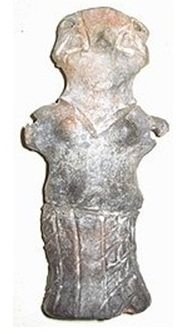
Fig. 4 – Shtatore gruaje veshur me ”Fustanellë” nga Vinça.
………………………………………………………
Në kulturën e Vinçës është ndeshur edhe një shtatore gruaje veshur me fustanellë, veshjen kombëtare pellazge/shqiptare, e cila tregon lidhje tjetër të banorëve të kësaj treve me stërgjyshët e shqiptarëve- pellazgët.
Shkrim i ngjashëm është ndeshur edhe në Tartaria të Rumanisë, rreth 120 km. në lindje të Vinçës, në një varse tjegulle, datuar e vitit 5300 p.e.s. Në varse (fig. 5) është shkruar germa “P” dhe pranë saj shprehja “PDor” (ose Pbor), e cila në gjuhën pellazge/shqipe do të thotë “Dora” ose “bora”. Këto plaka përmbajnë mbishkrimin e famshëm, për të cilin disa specialistë kanë shprehur mendimit se këto “symbols represent the earliest known form of writing in the world”, por disa i shohin si zhgaravina.
Mbishkrime të ngjashme janë ndeshur në të gjithë Europën jugë-lindore si në Greqi (Rrasa Dispilio), por edhe në Hungari, Bullgari, Rumani, Moldavi dhe në Ukrainën jugore. Në mbishkrim e Dispilios (fig. 5), datuar5300 p.e.s., duken mjaft të qarta germat E, F, C, V, I, L në pozicione të ndryshme, të cilat janë përdorur në alfabetet pellazg dhe etrusk.
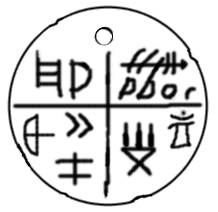
Fig.5
…………………………………….
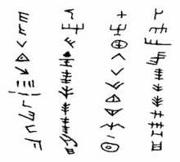
Fig.6
…………………………………………..
Të gjitha mbishkrimet e Vinçës, Tartarias dhe Dispilios tregojnë se shkrimi me germat e alfabetit pellazgo-etrusk është përdorur qysh gjatë mijëvjeçarit të 6 p.e.s. në rajonin e Ballkanit.
Nga vjetërsia këto shkrime janë shumë më të vjetër se sa shkrimi piktografik shumer (proto-Sumerian pictographic script) nga Uruku i Bagdatit, që deri tani është konsideruar si shkrimi më i vjetër në botë, krijuar rreth vitit 3300 p.e.s. dhe alfabetit egjiptian, i datuar rreth vitit 2900 p.e.s.
G. Katapano ( 1988) flet për alfabetin më të lashtë pellazg në Egjipt nga hieroglifet egjiptiane. Ato i ka krijuar Thoti, një iliro/pellazg bazuar në gjuhën pellazge. Të gjitha hieroglifet egjiptiane shpjegohen me bazë nga germat e alfabetit pellazg. Katapanl i daton hieroglifet egjiptiane 12.000 vjet p.e.s., gjë që nuk përputhet me të dhënat arkeologjike, që i daton ato 2900-2600 p.e.s.
Alfabeti pellazg ka vazhduar edhe gjatë kohës së bronzit, ku vërtetohet me gjetjet në Trojë, Kretë, Peloponez etj. Ai shfaqet në shkrimin e Linearit A të Kretës dhe shkrimin e Linearit B të Mikenës. Shkrimi Lineari B është interpretuar gabim nga anglezët Ventris dhe Kaduik, sikur i përkasin gjuhës greke. Duke punuar me këtë shkrim kemi gjetur të shkruara fjalë pellazge, që gjejnë shpjegimin e plotë në gjuhën shqipe (Peza L. & L.): në krahun e majtë të rrasës ndodhet shprehja e artë: I Z A I Z = Z I A Z I, që donë të thotë “ZI ASHT ZI”.

Drejtimi i leximit ←
I Z A I Z ← = → ZI A ZI = Zi asht Zi
………………………………………
Zbulimi i shprehjes I Z A I Z ← = → ZI A ZI = Zi asht Zi para dy vjetësh përbënte dokumentin më të lashtë të shkruar të gjuhës pellazge/shqipe (Peza L. & L. 2009 si e shekullit të 14 p.e.s., por sot vjetërsia e shkrimit të gjuhës pellazge/shqipe vërtetohet edhe disa mijëvjeçarë më i lashtë.
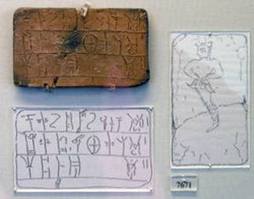
Fig.7 – Rrasa nr. 7671, që i përket shekullit të 14 p.e.s., ku lexohet shprehja pellazge.
………………………………………
Me rëndësi është të përmendim edhe mbishkrimin e quajtur Abecedari Marsiliana, i shekullit të 7 p.e.s., ku renditet të gjitha germat etruske/pellazge. Pellazgët dhe etruskët kanë përdorur formën bustrofedike të shkrimit, nga e djallja dhe e majta, si më poshtë (fig. 8):
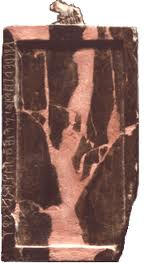
Fig.5.
………………………………………………………
I gjithë rajoni, ku ka qenë e përhapur kultura e Vinçës, Tartaria, Dispilios, Thesalisë, Cakranit, Maliqit, Kamnikut etj., pra rajoni i Ballkanit dhe i Egjeut gjatë kohës së neolitit dhe kohës së bronzit ka qenë banuar nga fiset pellazge, që përmenden në epikat e Homerit, autorët e tjerë antikë dhe që vërtetohen edhe nga gërmimet arkeologjike. Arkeologët italianë dhe amerikanë në akropolin e Athinës dhe vende tët tjera në Atikë kanë zbuluar ngjashmëri veglash dhe mjetesh me vendbanimet Sesklo dhe Dimini në Thesali, të njohura si pellazge, (Prokopiou & Smith, 1964). Po kështu prania e pellazgëve vërtetohet nga arkeologjia në malin Skourta në Boeoti ((French 1989-1990), në ishullin e Lemnit në Egje(Hefner E.D. 1927), në Mikenë dhe Peloponez ← Fig. 8 (Peza L. & L. 2009) etj. Herodoti dhe autorë të tjerë antikë thonë se pellazgët autoktonë kanë banuar të gjithë rajonin e Egjeut dhe ishujt mesdhetarë, para ardhjes së grekëve rreth shekullit të 6 p.e.s.
.jpg)
Shenjat – germa të alfabetit të përdorur në shkrimin e Linearit A dhe B.
………………………………………………..
Mbishkrimet Dipylon (i Athinës), Cumae (i Korinthit), Kupa e Nestorit, të datuara të shekujve 8-7 p.e.s. dhe që gjer tashti janë mbajtur si monumentet më të lashta shkrimore të gjuhës greke, u vërtetua se nuk kanë lidhje me këtë gjuhë. Të kësaj natyre janë edhe mbishkrimet e lashta të Kretës, të datuar fundi i shekullit të 7 fillimi i shekullit të 6 p.e.s. Në këto mbishkrime kemi zbuluam vetëm fjalë pellazge/shqipe, që dëshmon se ato janë shkruar në gjuhën pellazge. Nga ana tjetër grekët nuk përmenden as në “Iliadë” dhe “Odise” e Homerit, të përgatitura rreth viteve 750-700 p.e.s. Kështu del që fiset greke kanë ardhë në rajonin e Egjeut më vonë, në fillim të shekullit 6 p.e.s. dhe dokumentet më të vjetra greke në Lemn dhe Trojë etj. ndeshen jo para shekullit 5 p.e.s.
Zbulimi i fjalëve pellazge/shqipe “VIJ” dhe “DOR (ose bor)” në kulturën Vinça-Tartaria-Dispilio-Maliq-Cakran, mijëvjeçari i 6 p.e.s., tregon se kjo është gjuha më e lashtë e shkruar në botë me abecedarin e saj më të vjetrin në botë. Gjuha pellazge, shkrimi dhe alfabeti i saj, përbëjnë thelbin kulturor të Qytetërimi Pellazg, qytetërimi më i lashtë perëndimor, pjesë e të cilit janë Qytetërimi Minaik i Kretës, Qytetërimi i Trojës, Qytetërimi i Mikenës, Qytetërimi hitit, Qytetërimi etrusk etj. Qytetërimi Pellazg shfaqet qysh gjatë gurmesmit, rreth 12.000 vjet p.e.s.
(Referat i mbajtur në Konferencën e I-rë mbi Qytetërimin Pellazg, libri i përmbledhjeve, faqe 1-3, Tiranë 21-22 tetor 2011. Botuar për herë të parë në: Konferenca e I’rë mbi Qytetërimin Pellazg, Tiranë 21-22 tetor 2011, libri i përmbledhjeve f. 1-4)
===================================
THE PELASGIANS HAD INVENTED THE FIRST WRITING AND ALPHABET IN THE WORLD

Luftulla PEZA & Liljana PEZA
……………………………………….
In the History of the Alphabet, as the oldest one is mentioned the Egyptian Alphabet, created during 2900 BC. Later on, the Phoenician alphabet derived from it, during the 11 century BC, which consists of consonants only. Later on, it is said that the Phoenicians alphabet was taken by Greeks, which advanced it by adding the vowels as well. And based upon the Greek Alphabet the Latin one was developed. Not a single word was said about the Pelasgian alphabet, often mentioned by ancient writers, in the history of the alphabet.
Studying the history of the alphabets this chronological order of the alphabets is totally wrong. The first peoples in the world who had invented writing and used for their language the alphabet have been the Pelasgians, during the 6 millennium BC. The Pelasgian alphabet consisted of both, consonant and vowels.
In the Neolithic Vinca culture, extended in Balkan Peninsula during the 6-5-millenium BC, the ancient inscriptions are met not evaluated up to now from linguistic point of view. In an earth vessel (fig. 1) from Vinca is written the expression: IIIVIJV1, while in fig. 2 Capital “M” is written as well.
Fig. 1-Earth vessel with inscription from Vinca culture (5500-4500 BC)
Fig. 2-Fragment of the vessel with “M”
Original: IIIVIJV1, separated words: III VIJ V 1
The word “VIJ” is read “UIJ”, because in the Pelasgian/Etruscan inscriptions the letter “V” is equal to “U”. That is why the word will be read as “VIJ = UJË”, which means “the water” in the Pelasgian/Albanian language. That is the reason this inscription belong to the Pelasgian/Albanian language. Numbers 1 and III belong to Pelasgian language as well.
Many symbols of the Vinca culture, especially , are signs/letters used in Linear A and B scripts, and correspond to I, Y, Y, T, F, I, P, Z (S), N, F, Z (S), Th. The signs I, II, III, IIII, IIIII, IIIIII, X, XX, etc., which refer to the later Etruscan numbers I, II, III, IV, V, VI etc., named later as “Roman numbers”.
In addition to this other signs from the Vinca culture as: indicate the dwellers of Vinca had believed to the Pelasgian god Zeus.
Similar letters “A” and “M” in the Neolithic Maliq-Kamnik culture (near the town of Korça, eastern Albania) and Cakran culture (near the town of Fier, west Albania) are met. These important data indicate that script has a wide extension in the Balkan region during the Neolithic time.
Fustanella is the Albanian national dress. The fact that “Fustanella” in the Vinca culture is met as well (fig. 4), indicate the antiquity of this dress. Fustanella is known from the Bronze Age of Mycenae as well, together with Pelasgian/Albanian script (Peza L & L. 2009). All these facts, mentioned above demonstrate an old Fig. 4- Women Statue dressed in “Fustanella” from Vinca.
In the culture of Vinca a statue of a woman worn in Fustanella, an Albanian/Pelasgian national dress shows another connection to the inhabitants of this territory with the Albanian-Pelasgian forefathers since the Neolithic time.
A similar script in Tartaria of Romania is met, in a terracotta necklace, dated 5300 BC. In the necklace (fig. 5) is written a great letter “P” and nearby the phrase “PDor” (or Pbor). These words in the Pelasgian/Albanian language mean “Hand” and “Snow”.
In the Tartarias tablet are written famous inscription as well, about which some scholars have expressed their opinion as an earliest known form of the writing in the world, but some others see them as an accidental scratch.
Similar inscriptions are met in all around the south-eastern Europe, Greece (Dispilios tablet), Hungary, Bulgaria, Romania, and Moldavia and in south Ukraine as well. In the Dispilios inscription (fig. 5), dated 5300 BC, are seen very well the letters E, F, C, V, I, L in the different positions, which have been used in the Pelasgian and Etruscan alphabets.
The Vinca, Tartarias and Dispilios inscriptions show clearly that in the Balkan region since during 6 millennium BC the writing with the letters of the Pelasgian and Etruscan alphabet have been in use.
This script is older than proto-Sumerian pictographic script from Uruk (Bagdad), considered as the oldest script in the world, created 3300 BC and Egyptian alphabet, dated around 2900 BC.
G. Catapano (1988) has written about the oldest Pelasgian alphabet in Egypt from Egyptian hieroglyphs. He underlines that Egyptian hieroglyphic alphabet is created by Thot, based on in the Pelasgian (Illyrian) language. All Egyptian hieroglyphs have their meaning in the Pelasgian/Albanian language. Catapano date this alphabet 12.000 BC, which do not agree with archaeological data, dating them from 2900-2600 BC.
Pelasgian alphabet continues during the Bronze Age as well, demonstrated with the founds in Troja, Crete, Peloponnese etc. It appeared in Linear A script in Crete and in Linear B script in Mikena. Working with tablets with Linear B script we have verified that the conclusions of M. Ventris and J. Chadwick about the Linear B script as “it is an old form of the Greek language” is a wrong interpretation. We have found the Pelasgian/Albanian words written in it, which are explained completely by Albanian language (Peza L. & L.2009): in the left corner of the tablet is written the gold expression:
I Z A I Z ← (reading) = → Z I A Z I, which means “ZI ASHT ZI” = mourning is mourning.
Discovery of the expression I Z A I Z ← = → ZI A ZI = Zi asht Zi = mourning is mourning, has been the oldest document written in Pelasgian/Albanian language in 14 century BC (Peza L. & L. 2009), but now the antiquity of the Pelasgian writing is even some millennia older as well.
Direction of reading ← I Z A I Z ← = → ZI A ZI = ZI ASHT Zi = Mourning is mourning
Fig. 5- Tablet nr. 7671 belong to 14 century BC, where the Pelasgian/Albanian expression is written.-Fig. 7
Marsiliana Abecedarian of the 7 century BC is a very important document, because in it are arranged in order all Pelasgian/Etruscan letters. Pelasgians and Etruscans used boustrophedon form of the writing, from right to left and inversely as below (fig. 8):
All the region that had covered Vinca, Tartaria, Dispilio, Thesalian, Cakran, Maliq, Kamnik cultures etc. i.e. region of Balkan and Aegean during the Neolithic and Bronze age have been populated by Pelasgian tribes mentioned in the Homer’s epics and by other authors of antiquity are certified by archaeological excavations as well. Italian and American archaeologist in the Athenian acropolis and other sites of Attica had discovered much similarity in tools and implements with the dwelling places of Sesklo and Dimini in Thessaly, known as Pelasgian ones (Prokopiou & Smith, 1964). Pelasgian presence is proved by archaeology in the Skourta mountain in Boeotia ((French 1989-1990), in Lemni island in Aegean Sea (Hefner E.D. 1927), in Mycenae and Peloponnese (Peza L. & L. 2009) etc. Herodotus and other antiques writers say that autochthonous Pelasgians have all dwelled in the territory of the Aegean and Mediterranean islands before the coming of the Greeks at the beginning of the 6 century BC. Dipylon inscription (inscription of Athena), Cumae inscription (inscription of Corinth) and Nestor Cup, belonging to 8-7 century BC, and Cretan inscriptions, dated the end of the 7 century- beginning of 6 century BC, that till now are mentioned as the oldest scriptural monuments of the Greek language, are testified that they have no connection with this language. In these inscriptions we have discovered only Pelasgian/Albanians words, which demonstrate that these inscriptions are written in the Pelasgian language. On the other hand the Greeks are not mentioned in Homer’s “Iliad” and “Odyssey”, prepared around 750 and 700 years BC. So the Helene tribes had come in the Aegean region at the beginning of 6 century BC and the oldest documents for the presence of the Hellenes in Lemni Island and Troy are met not before the 5th century BC.
Discovery of the Pelasgian/Albanian words “VIJ” and “DOR (or bor)” [Water and Hand (or snow)] in Vinca/Tartaria culture of the 6 millennium BC, indicate that the Pelasgian is the oldest language written in the world with its oldest abecedarian in the world as well. Pelasgian language, its writing and alphabet constitute the cultural core of the Pelasgian Civilisation, the oldest western one, parts of which are Minoan, Trojan, Mycenaean, Hittite, and Etruscan Civilisation. The Pelasgian Civilisation appears since Mesolithic, around 12.000 years BC.
1. Referat in the First Conference on Pelasgian Civilisation hold in Tirana 21-22 October 2011, abstract book, pp.4-6.





